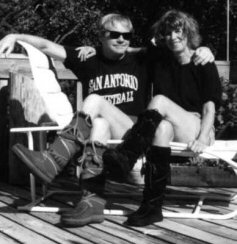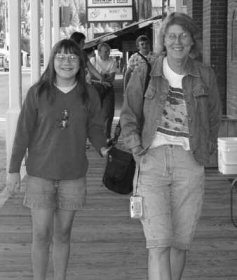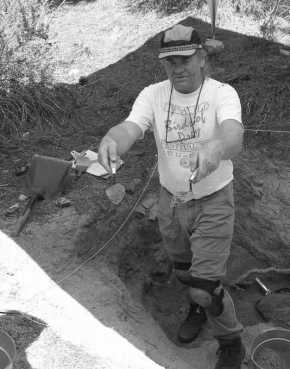The PIT Experience - Passport in Time
Main menu:
PIT Highlights > PITsters' Corner
The PIT Experience: Life Lessons and So Much More
by Jane Kersting, PIT Volunteer
I often question the importance of my job in the context of what is happening in the world. How can I justify restoring old cabins or recording Chinese mining sites while whole cities are being demolished and people are dying? While visiting a PIT project, I met Jane Kersting, and she answered my question in a more profound way than I ever could have imagined. Her story follows.—Jill Osborn, Former National Coordinator, Passport in Time

Last March, I received a much anticipated phone call from a PIT project leader on the Boise NF, inviting me back to the PIT family after a hiatus of over a decade. My husband and I were fortunate to be two of the pioneer volunteers on one of the first projects hosted by Gordon Peters in 1990 on the Superior NF in Minnesota. (Photo: Jim and Jane Kerstig at home in the Northland in the early 1990s, sporting their new moosehide mukluks.)When we weren’t being eaten by black flies and bomber-sized mosquitoes, the conversation often led to the bonding that we felt as a group, our shared worldview, and understanding of our “humanness.” The almost instant bonding we felt with other PIT volunteers was especially gratifying after an experience we had with our application for a marriage license. We had written “human” in the space beside “Race” and found when we returned to the courthouse, that the application had been altered. The powers that be decided the entry was inappropriate and human” was whited out, quite literally, much to our anthropological dismay.
We volunteered at the Misiano site for three summers before work interfered, and PIT opportunities close to our home were harder to find.

In June, we joined the PIT volunteers on the Boise NF. It was close to solstice, a time of reflection, and my 10-year-old granddaughter was sharing my tent (Photo: Jane Kerstig and her granddaughter Jennifer Gile enjoy a walking tour of historic Idaho City during the 2003 Continuing Excavations on Ophir Creek project on the Boise NF). A conversation in a lovely museum in an old Idaho mining town (population 62, where the mayor serves because he loves the community) took me back to the days after 9/11. I was profoundly affected on many levels, but mostly because I understood that the world would never be the same for my grandchildren. They lost their innocence, their trust, and their feeling of safety. The price of instant news, instant visuals, instant commentary, and televised war is high. Many tears were shed in a vain attempt to answer an 8 year old’s questions about “the incident” and “that bad man.” A video entitled “Tibet” depicting their simple life, with Phillip Glass music in perfect synchrony, was the only comfort—a touch of “humanness” in what must have seemed like a crazy world to a child. Our children may be denied innocent school pranks, may never know the joy of taking squirt guns to school in those last hot days before summer vacation.
For a week, the PIT volunteers, Boise NF archaeologists, visitors, townspeople, and grandchildren were united in a small community doing what we as Americans do best—sharing hopes, dreams, stories, and the freedom to be together without fear. Eating spaghetti on picnic tables in a town square. Watching children feeding a stray dog. Appreciating PIT organizers who go the extra mile for volunteers. The words “kindred spirits” and “family” were repeated often in a group that had just met. As the week went on, s’mores became more gourmet. Marshmallows were toasted to a perfect bronze or instantly blackened and rated by opposing camps. Laughter was the rule as we talked about favorite candy bars, ice cream, and childhood horror stories. The latest Harry Potter book was the hot topic, not the Washington Post. It was an innocent time. The last morning, my 10-year-old granddaughter remarked that she had “never heard adults discuss candy bars with such intensity.” Her life lesson was that adults could be so honest and admit that they ate candy at all, much less salivate over it. Adult life lessons included an appreciation for the Chinese culture that coexisted with the Anglos in a common goal to mine precious metals from the earth, while at times teaching the dominant culture a thing or two about mining. It was such a joy to spend time with people with no hidden agendas—a respite from our busy lives, a counterpoint to life out of balance.” We understood our connectedness as human beings—a life lesson worth learning.

 (Photos Left and Right: Continuing Excavations on Ophir Creek, Boise NF, Idaho, 2003. Jim comparing soil samples. Jane screening for artifacts.)
(Photos Left and Right: Continuing Excavations on Ophir Creek, Boise NF, Idaho, 2003. Jim comparing soil samples. Jane screening for artifacts.)